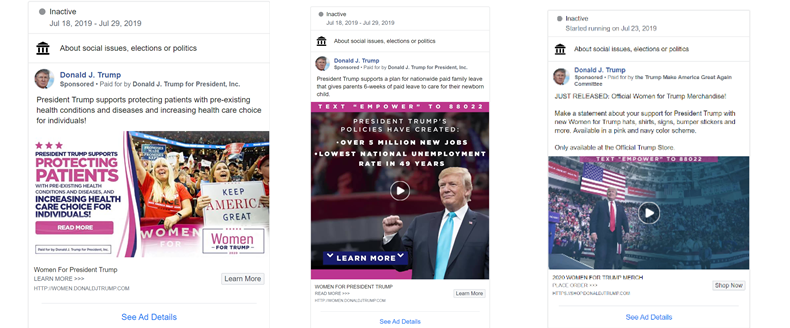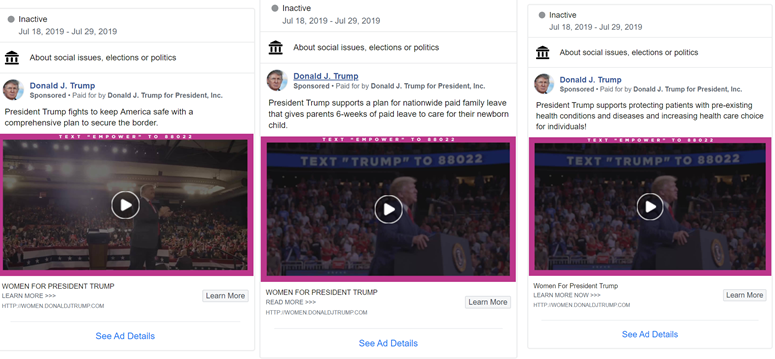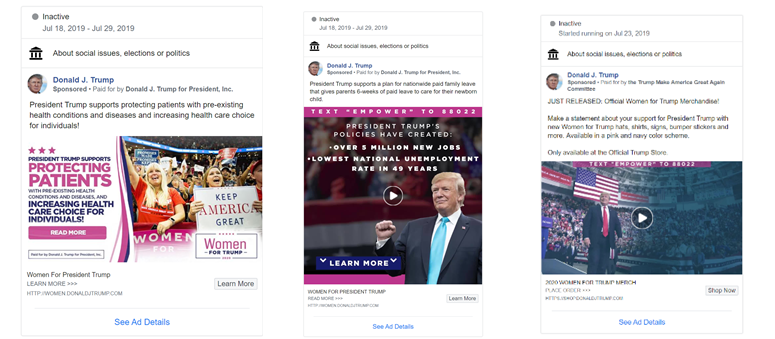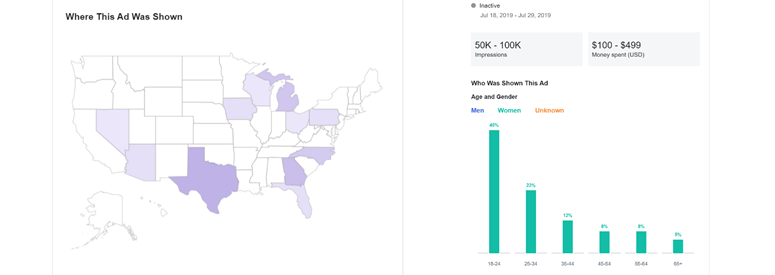New Epolitics.com contributor! Myles Bugbee is a digital strategist who has consulted from city council to congressional to presidential campaigns. During the 2018 cycle, he directed Sen. Jon Tester’s digital program and was dubbed “Mr. Technology” by the seven-fingered dirt farmer. Check out his excellent analysis of Trump’s recent Facebook advertising strategy below.
Months before the general election begins, the Trump campaign is quietly testing a new layer to its base-first strategy: running Facebook ads on traditionally Democratic issues in key states.
While political scientists find diminishing recall from early ads, research shows that “information that comes early in a political campaign will more strongly influence the reception, interpretation, and evaluation of new campaign information.” In an election as close as 2020, it could make the difference.
The Trump Campaign Adapts for 2020
This cycle, the campaign is building on its 2016 playbook with merchandise ads tapping into cultural grievances and zeitgeist moments, and incendiary email acquisition and direct-donate ads on immigration and guns. Brad Parscale, Trump’s then-digital director, claimed that nearly all of their 2016 digital ad spending focused on mobilization and fundraising.
Earlier this year, Judd Legum uncovered that the Trump campaign was running testimonial video ads featuring different actors delivering the same lines.
A new Trump digital persuasion ad track (as noted by the content category in the UTM tracking code) emerged in July around the launch of the Women for Trump affinity group.
Along with list-building ads, the Trump campaign has run 89 ads on traditionally Democratic issues like “nationwide paid family leave” and “protecting patients with pre-existing health conditions.” In one ad series, copy on health care accompanied a 12-second video that touted Trump’s claimed support for gun background checks.
Another copy variant that focused on more typical Trump issue turf like immigration ran with the same video that mentioned background checks.
The campaign also tested the paid family leave message with a 12-second video on economic metrics like the unemployment rate, and static image ads on paid family leave and pre-existing conditions.
All of the Women for Trump Facebook issue ads in July linked to a landing page with the text of an op-ed claiming that “Women are winning in the Trump economy.”
Going against the digital best practice of matching landing pages to ad copy, the pasted excerpt on Trump’s record didn’t include a single word about pre-existing conditions or paid leave.
The ads around the Women for Trump launch shared the same gender targeting, but the issue-focused ads ran in battleground states like Wisconsin and Pennsylvania, while the merchandise ads typically ran nationwide. One of the paid family leave ads generated 50,000-100,000 impressions with age targeting that skewed toward younger women.
Several messages tested in mid-July reappeared in late August when the campaign launched a new round of Women for Trump ads that once again highlighted Trump’s ostensible support for paid family leave legislation. The pre-existing conditions language was dropped and the coverage language was changed to “health care choice for all.”
Will These Ads Work?
While the medium is different, Donald Trump isn’t the first Presidential candidate to test messages that confound voters’ expectations. Michael Dukakis’s infamous tank ride and Paul Ryan’s soup kitchen photo-op demonstrate the risks of such appeals.
Research on issue trespassing indicates that such appeals need to be seen as credible to resonate with voters. Voters often rely on cues like issue ownership by a political party. Health care has long been an issue where Democrats are favored, and it helped propel gains last cycle after the 2017 ObamaCare repeal vote.
Recent polling shows that healthcare is still a top issue for swing voters. With the Supreme Court likely to take up a pending lawsuit that could invalidate the entire Affordable Care Act, Trump’s early health care messages could signal an effort to inoculate himself on an issue that already cost his party control of the House.
The paid family leave ads may constitute a more proactive posture, seizing issue ground in an area where Trump’s positioning in less well-known. Even in this saturated political environment, only 39% of swing voters are paying close attention to political news, and social policies like family leave often fall into the electoral blind spot.
Sen. Cory Gardner used a similar tactic in 2014 when he blunted a “War on Women” messaging effort with ads focusing on his support for over-the-counter contraceptives, adding new policy information for persuadable voters.
Last cycle, now-Sen. Josh Hawley countered attacks on his support for a lawsuit taking away protections for patients with pre-existing conditions with a direct-to-camera ad highlighting his son’s health condition.
Trump has already moved voters with unexpected positioning like promising to protect entitlement programs like Social Security and Medicare. In 2016, he was seen as the most moderate Republican Presidential candidate since 1980.
How Democrats Can Respond
These July and August ad tracks may not be the last we see of this digital messaging strategy. Facebook’s tracking pixel allows an advertiser to retarget people who visit a landing page like the one the Trump campaign connected to the health care ads.
Persuadable voters who click on the ads could be used to model lookalike audiences and added to custom audiences that receive more ads, passing through a digital funnel months before the Democrats choose their nominee.
Major Democratic outside groups are already planning planning (and running) extensive digital persuasion campaigns in battleground states. If Trump continues to move into Democratic turf, these groups may consider countering with articles from third-party sources and authentic testimonial videos that benefit from Facebook’s algorithm changes.
Political scientists recently found that shifting the “balance of headlines” in social media news feeds can shape perceptions even about a highly defined political candidate like Trump.
While Donald Trump channels Stephen Miller at rallies and in tweets, he’s striking a tone more like Ivanka Trump in key states. It’s not too late for Democrats to push back on Trump’s latest branding gambit.




